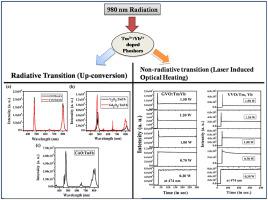Our official English website, www.x-mol.net, welcomes your feedback! (Note: you will need to create a separate account there.)
Effect of host on the radiative (upconversion emission) as well as non-radiative relaxation (laser induced optical heating) in Tm3+/Yb3+ co-doped phosphors
Journal of Luminescence ( IF 3.6 ) Pub Date : 2020-10-01 , DOI: 10.1016/j.jlumin.2020.117421 Abhishek Dwivedi , Devendra Kumar , S.B. Rai , A.K. Rai
Journal of Luminescence ( IF 3.6 ) Pub Date : 2020-10-01 , DOI: 10.1016/j.jlumin.2020.117421 Abhishek Dwivedi , Devendra Kumar , S.B. Rai , A.K. Rai

|
Abstract Tm3+/Yb3+ co-doped YVO4 (YVO:Tm, Yb); GdVO4 (GVO:Tm, Yb); Y2O3 (YO:Tm, Yb); Gd2O3 (GdO:Tm, Yb) and CaAl2O4 (CAO:Tm, Yb) phosphor samples have been synthesized using high temperature Solid State Reaction method. X-ray diffraction measurements confirm the pure phase formation of all the five phosphors. Fourier Transform Infrared (FTIR) measurements give information about the different vibrational groups and also the phonon frequency of the host materials. The radiative as well as non-radiative phenomena are observed in all phosphors on excitation with 980 nm laser radiation. Radiative process gives upconversion (UC) emission in Visible and NIR regions due to Tm3+ ion. On the other hand the non-radiative processes generate heat in the material known as laser induced optical heating. The Upconversion (UC) emission behavior of all the phosphors has been investigated on 980 nm excitation which gives intense blue, weak red and prominent NIR emissions. The overall UC emission intensity is maximum in Tm3+/Yb3+ co-doped GdVO4 phosphor as compared to the other four. The crystalline behavior, surface morphology and vibrational behavior play important role in emissive properties. Laser induced optical heating is observed in all the phosphors which show an increase in heating in the phosphors with the increase in pump power. The optical heating is affected by phonon frequencies of the phosphor materials. In the present work, heating is more prominent in the case of vanadate host (a self-activated host) which has phonon frequency near about 800 cm−1. Overall, the UC emission and laser induced optical heating is dominant in self-activated vanadate host as compared to the other oxide hosts. In between vanadate hosts, GVO:Tm, Yb shows better UC emission as well as laser induced optical heating.
中文翻译:

主体对 Tm3+/Yb3+ 共掺杂磷光体中辐射(上转换发射)和非辐射弛豫(激光诱导光学加热)的影响
摘要 Tm3+/Yb3+共掺杂YVO4(YVO:Tm,Yb);GdVO4 (GVO:Tm, Yb); Y2O3 (YO:Tm, Yb); Gd2O3 (GdO:Tm, Yb) 和 CaAl2O4 (CAO:Tm, Yb) 荧光粉样品已使用高温固态反应方法合成。X 射线衍射测量证实了所有五种磷光体的纯相形成。傅里叶变换红外 (FTIR) 测量可提供有关不同振动群的信息以及主体材料的声子频率。在用 980 nm 激光辐射激发时,在所有磷光体中都观察到辐射和非辐射现象。由于 Tm3+ 离子,辐射过程在可见光和 NIR 区域产生上转换 (UC) 发射。另一方面,非辐射过程在材料中产生热量,称为激光诱导光学加热。已在 980 nm 激发下研究了所有磷光体的上转换 (UC) 发射行为,该激发产生强烈的蓝色、弱红色和突出的 NIR 发射。与其他四种相比,Tm3+/Yb3+ 共掺杂 GdVO4 荧光粉的整体 UC 发射强度最大。结晶行为、表面形态和振动行为在发射特性中起着重要作用。在所有磷光体中都观察到激光诱导的光学加热,这表明磷光体中的加热随着泵浦功率的增加而增加。光学加热受磷光体材料的声子频率影响。在目前的工作中,在声子频率接近 800 cm-1 的钒酸盐主体(自激活主体)的情况下,加热更为突出。全面的,与其他氧化物主体相比,UC 发射和激光诱导的光学加热在自激活钒酸盐主体中占主导地位。在钒酸盐主体之间,GVO:Tm、Yb 显示出更好的 UC 发射以及激光诱导的光学加热。
更新日期:2020-10-01
中文翻译:

主体对 Tm3+/Yb3+ 共掺杂磷光体中辐射(上转换发射)和非辐射弛豫(激光诱导光学加热)的影响
摘要 Tm3+/Yb3+共掺杂YVO4(YVO:Tm,Yb);GdVO4 (GVO:Tm, Yb); Y2O3 (YO:Tm, Yb); Gd2O3 (GdO:Tm, Yb) 和 CaAl2O4 (CAO:Tm, Yb) 荧光粉样品已使用高温固态反应方法合成。X 射线衍射测量证实了所有五种磷光体的纯相形成。傅里叶变换红外 (FTIR) 测量可提供有关不同振动群的信息以及主体材料的声子频率。在用 980 nm 激光辐射激发时,在所有磷光体中都观察到辐射和非辐射现象。由于 Tm3+ 离子,辐射过程在可见光和 NIR 区域产生上转换 (UC) 发射。另一方面,非辐射过程在材料中产生热量,称为激光诱导光学加热。已在 980 nm 激发下研究了所有磷光体的上转换 (UC) 发射行为,该激发产生强烈的蓝色、弱红色和突出的 NIR 发射。与其他四种相比,Tm3+/Yb3+ 共掺杂 GdVO4 荧光粉的整体 UC 发射强度最大。结晶行为、表面形态和振动行为在发射特性中起着重要作用。在所有磷光体中都观察到激光诱导的光学加热,这表明磷光体中的加热随着泵浦功率的增加而增加。光学加热受磷光体材料的声子频率影响。在目前的工作中,在声子频率接近 800 cm-1 的钒酸盐主体(自激活主体)的情况下,加热更为突出。全面的,与其他氧化物主体相比,UC 发射和激光诱导的光学加热在自激活钒酸盐主体中占主导地位。在钒酸盐主体之间,GVO:Tm、Yb 显示出更好的 UC 发射以及激光诱导的光学加热。


























 京公网安备 11010802027423号
京公网安备 11010802027423号